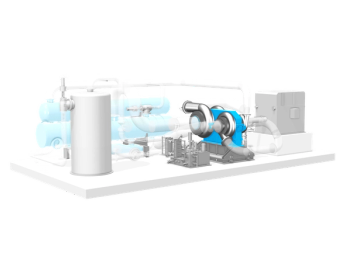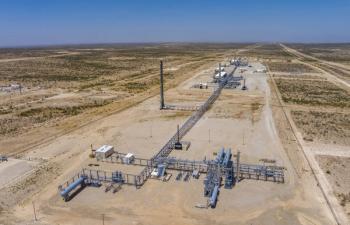
Turbines, on a roll
Natural gas and oil production has gone way up the past few years here in the United States. A few years ago there were many skeptics who thought that the newly produced shale franking gas and oil production was only a bubble to soon pop, but now the experts all seem to agree that US gas and oil production is here to stay for the long run. Both oil and gas production has risen to the point where it is predicted that the US will become oil and gas independent within 10 years. The general consensus is now that fracking, if handled prudently and closely monitored, is safe and acceptable.
There are three major producing areas for shale oil and gas in the US: the first is the large Eagle Ford play in Texas, the second is in North Dakota and the third is located in Pennsylvania. New York has blocked fracking so far as being unsafe. There is another large US potential producing area that is located in Arkansas that has recently been announced, but it will take several years to become a reality. The Eagle Ford region runs deep into northern Mexico, but Pemex, the national oil administry does not have the funds or know how to move forward with shale fracking. Therefore, the Mexican government has recently passed a new law to allow foreign companies, particularly the US, to frack drill in Mexico, but it will take time for gas and oil to start flowing.
Lack of pipelines in certain areas is limiting the production and trucking and rail is used to get the oil to the refineries. A recent freight train derailment caused a terrible fire in North Dakota as recently shown on TV. Even so, rail to transport the oil to the refineries will continue to be used.
The increase in oil and gas production in the US has given the needed incentives for the Petrochem industries to start building large new Petrochem plants in the Gulf region. A 700 mile long 40 inch diameter gas pipeline has been approved to pump gas to the auto region in Mexico. Natural gas liquefaction plants are being built to ship LNG to Japan and other far off places now that the price of gas has leveled off and stabilized at about 4 dollars a million BTU. All of these things have greatly improved the economy of the US and reduced unemployment.
Coal Outlook in the US
Recently the EPA has at last, after long delays, ordered US companies with coal burning power plants to reduce the emission of C02 to lower levels. However, coal will remain in use in the US a long time. Production of electric power is predicted to remain at present levels or fall off only slightly while the production of electric power by burning natural gas is predicted to increase to meet the future growing demands. At the present time, a little over half of our US electric power is generated by coal.
A number of the newer coal burning plants will be converted to burn natural gas. The old coal plants will be retired. The future looks bright for high efficiency combined cycles to be installed in the US in increasing numbers.
Rosy Future for Combined Cycle Power Plants in the US
Conditions are now right for the combined cycle to start being installed in increasing numbers in the US. The electric utility companies are now accepting the long range production of fracking natural gas production and are starting to move forward with highly efficient combined cycles power plants. Two examples are given as follows for new US CC power plants.
Siemens has received an order for two H-class gas turbines for the Patriot power plant in Pennsylvania. It is to have a capacity of 829 MW and is scheduled to start up in 2016. It is the 27th H-class gas turbine sold by Siemens worldwide. The plant will burn local Pennsylvania shale natural gas. It will have two SGT6-8000H gas turbines in a single shaft arrangement with one generator, each with one SST6-5000 steam turbine. There will be a duplicate sister power plant named Liberty.
The second example is a 540 MW combined cycle undergoing installation at Marble Falls northwest of Austin, Texas. This installation is based on using two GE HD Frame 7 FA advanced units. The plant is expected to start up this summer and will replace an existing 37 year old natural gas fueled plant and will be 120 MW larger but will burn less fuel. It will be powered by shale fracked gas.
GE Aero Has New GT Offerings
General Electric Power & Water of Houston, Texas has four new bulletins on its Aero gas
turbine engine offerings. The first covers the LM6000-PH (DLE) unit rated ISO at 50.959 MW dry and 54.263 MW with Sprint water compressor cooling. GE has optimized the output of the unit by running the LP compressor at 3930 RPM instead of 3600 thus increasing air flow accordingly through its CF6-80E1 gas generator whereas power is proportional to air flow. This revised speed now requires a load gear for both the 50 Hz and 60 Hz units. The second bulletin discusses the LM6000-PG (SAC) unit. This unit has a rating of 52.784 MW Unabated, 55.617 with water NOx control and 58.036 with water/Sprint. The LP compressor also runs at 3930 RPM and incorporates the same CF6-80E1 gas generator.
The third bulletin presents the latest LMS 100 intercooled unit with a 43 to 44 % efficiency. The 50 Hz version now has an ISO rating of 100.1 MW dry and 104.1 MW with water injection for 25 rpm NOx control. The 60 Hz unit as a rating of 105.8 MW and 101.2 MW respectively. Both have a 42.1 pressure ratio with an increase of air flow to 500 lb/sec. The unit is now equipped with a much improved new 6 pass cross/counter flow water type intercooler with a cooling water outlet temperature of about 200 °F. Therefore, the cooling water flow is greatly reduced and the hotter water makes it more practical to recover a portion of this heat. This advancement makes it possible to have a 1 to 5 psig HRSG for admission of steam to a steam turbine in the combined cycle mode.
The fourth bulletin covers operating experience of the LMS 100. A total of 51 LMS 100 units are in operation around the world with 32 units in California alone. Argentina, Chile, Canada, Italy, Russia,Turkey, New Zealand, Australia and Venezuela are other world locations.
It is interesting to note that the two LMS 100 (100 MW size) units for Russia are installed in Sochi, Russia and will be furnishing power for the coming World Olympics in a few weeks. The worldwide TV should be carrying a spot on these two US GE Olympic winning units. Look for the showing.
Newsletter
Power your knowledge with the latest in turbine technology, engineering advances, and energy solutions—subscribe to Turbomachinery International today.




